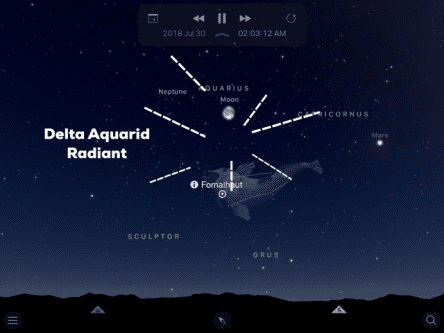Highlights of the July Sky 2018


• July 1 – Before sunrise, look to the southwest where you will see Mars about 6 degrees below the waning crescent moon.

At around 9:30 PM this evening, go outside and face west, if you have a clear view down to the horizon, you might see the elusive planet Mercury. Binoculars will be a big help. Look for Mercury in this part of the sky for the next 17 days.
• July 4 – On this day in 1997, NASA’s Pathfinder spacecraft, along with the Sojourner rover, lands on Mars.
• July 6 – Earth is at aphelion, its most distant point in its orbit from the Sun. Normally, the average Earth-Sun distance is about 93 million miles (which, by the way, is a distance unit that astronomers call the “astronomical unit”, or AU for short). Today, at 12:00 PM, the Earth will be 94.5 million miles from the Sun.
The moon is at last quarter.

• July 9 – After sunset, look west to see the planet Venus just one degree (that’s one pinkie finger width held out at arm’s length) form Regulus, the brightest star in the constellation of Leo.

• July 10 – During the hours of dawn, look to the east to see the sliver of the waning crescent moon a half of a degree from Aldebaran, the brightest star in the constellation of Taurus.

• July 12 – Dwarf planet Pluto is at opposition, which means that it lies opposite the Sun as seen in our sky from here on Earth. Look for Pluto about 15 degrees to the west of Saturn and just a few arcseconds (one degree is divided into 60 arcminutes and one arcminute is divided into 60 arcseconds) west of the star 50 Sagittarii. You will need a star chart and a telescope of 8” aperture or larger to locate it.
• July 13 The moon is at perigee, its most distant point in its orbit, at 3:25 AM CDT at a distance of 222,097 miles away.

• July 14 – On this day in 1994, 21 fragments of Comet Shoemaker-Levy 9, plunge into Jupiter as thousands watch from here on Earth. The impacts leave dark scars in the Jovian atmosphere and is a not-so-subtle reminder that our planet is in a cosmic shooting gallery.
• July 19 – The moon is at first quarter this evening.

• July 25 – Look for the moon adjacent to the planet Saturn this evening.
• July 27 – Mars is at opposition (see the July Feature article to learn more).
The moon is at apogee, its most distant point in its orbit, at 12:44 AM CDT, at a distance of 252,415 miles.
Full moon officially occurs at 3:20 PM CDT.

• July 30 – The Delta Aquarid meteor shower peaks this night. On optimal dates, this shower can produce 10-20 meteors per hour during the peak times. Unfortunately, the bright moon will obscure all but the brightest ones this year. However, this meteor shower is a long and rambling one that last from early July up until late August, it even overlaps with next month’s Perseid meteor shower. So, if you time your observing to occur on nights without the moon, you might still see a few of these meteors streaking across the sky. Because Delta Aquarids are rather faint, you must have good dark skies to see them.
• July 31 – The planet Mars is at its closest point to Earth, at distance of 35.8 million miles.
